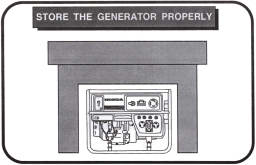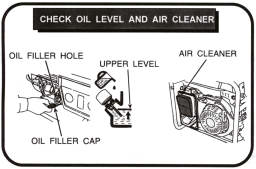
| | Check Oil And Air Cleaner Before Use | |  | Check the air cleaner before use. |  | Check the engine oil before use. |
|
|
VOLTAGE SELECTOR SWITCH (if equipped) The voltage selector switches the main power carrying windings of the generator to produce "120V ONLY" or "120/240V". If a 240V appliance is connected to the 4-prong receptacle, the switch must be in the "120/240V" position. If a 120V appliance ONLY is being connected to any of the 120V 3-prong receptacles, select the "120V ONLY" position. The benefit of this is to get maximum power from the 120V 30A locking receptacle. Check Switch Position Before You Start UpIf your generator has this switch then read carefully. Honda and some other generators, with 120/240V capabilities, have two separate main windings. Each winding is capable of the same output. The voltage selector switch changes the two main windings from a PARALLEL connection for ("120V ONLY") to a SERIES connection for the "120/240V" position. In the "120V ONLY" position, the power of the two main windings are connected in parallel (beyond the circuit breakers) and full power can be obtained from the 30A 120V receptacle. When in the "120V ONLY" position, the 240V receptacle cannot be used. With the voltage selector in the "120/240V" position, the power of each main winding is evenly distributed to all the outlets. It is important that the power connected to the different receptacles be applied equally to avoid overloading any one main winding.
|
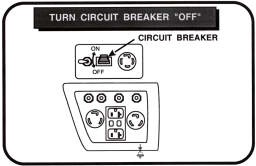
| | | Voltage Selector Switch |  | Allows simultaneous use of 120V and 120/240V receptacles. |  | "120 ONLY" position: maximum power from locking plug. |  | "120/240V ONLY" position: simultaneous use. |
|
|
BALANCE THE LOAD The generator has two separate main power producing circuits. These two circuits supply equal power to the receptacles shown when the voltage selector switch is in the "120/240V" position. When two or more receptacles are used; prevent overloading by dividing the loads between the two power circuits. Example: (ES7500 rated current draw is 50A) Receptacle 2 has a 15A load connected to it. Receptacle 3 has a 15A load connected to it. Both receptacles are powered by the main power circuit 1. The equation tells us that the total power draw on Circuit 1 is 30A (greater than 25A). This is a substantial overload to this circuit. To eliminate the excess power draw on circuit 1, the load from receptacle "3" should be switched to receptacle "1". Now circuit 1 is powering a 15A load (less than 25A) and circuit 2 is powering a 15A load (less than 25A). When the voltage selector is in the "120V ONLY" position, do not exceed the rated capacity of any one receptacle. For all receptacles used, do not exceed the rated load capacity of the generator.
|
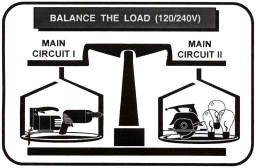
| | Balance The Load | |  | "120/240V" position. |  | Connect loads to balance the two main windings. |
|
|
AUTO-THROTTLE or IDLE CONTROL The auto-throttle system automatically reduces engine speed when all loads are turned off or disconnected. When appliances are turned on or reconnected, the engine returns to the rated speed.  The auto-throttle system will not respond to electrical loads of less than 1 ampere. The auto-throttle system will not respond to electrical loads of less than 1 ampere.
 The system is not effective for use with appliances that require only momentary power. Leave the auto-throttle OFF if an appliance cycles on and off frequently. The system is not effective for use with appliances that require only momentary power. Leave the auto-throttle OFF if an appliance cycles on and off frequently.
 To avoid extended warm-up periods, keep the switch OFF until the engine reaches operating temperature. To avoid extended warm-up periods, keep the switch OFF until the engine reaches operating temperature.
 Appliances with large start-up power demands may cause the engine to be overloaded and keep it from reaching normal operating RPM. Turn the auto-throttle to the OFF position and connect the appliance to the generator. If the engine is still overloaded and cannot reach normal operating rpm, check that the appliance does not exceed the rated load capacity of the generator. Appliances with large start-up power demands may cause the engine to be overloaded and keep it from reaching normal operating RPM. Turn the auto-throttle to the OFF position and connect the appliance to the generator. If the engine is still overloaded and cannot reach normal operating rpm, check that the appliance does not exceed the rated load capacity of the generator.
If the generator is equipped with a pilot light or volt meter and the auto-throttle is ON but no load is connected:  The pilot light will be dimmer. The pilot light will be dimmer.
 The voltmeter will display less than the normal output voltage (120V or 240V). The voltmeter will display less than the normal output voltage (120V or 240V).
|
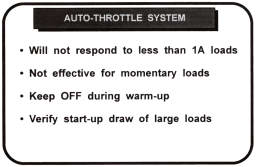
| | Auto-Throttle OR Idle Control | |  | Lower fuel consumption |  | Reduced noise |
|
|
GFCI APPLICATIONS In certain applications, Honda industrial generators fall under OSHA regulations. One such regulation is that 120V, 15 and 20 ampere receptacles be protected by Ground Fault Circuit Interrupters (GFCI) automatically open the power circuit in the event there is a current leakage in the tool or appliance plugged into the GFCI receptacle. The GFCI will open the circuit protecting the operator from ground faults. Examples of ground fault current is the current which would flow through a person who is using an appliance with faulty insulation and, at the same time, is in contact with an electrical ground such as a plumbing fixture, wet floor, or earth. The ground fault circuit interrupter receptacle will not protect against short circuits or overloads. The circuit breaker or circuit protector in the control panel, which supplies power to the circuit, provides that protection.
|
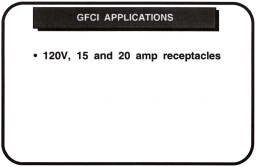
| | GFCI | |  | GFCI protection is required for certain applications. |  | Must protect all 15 and 20 ampere 120V receptacles. |
|
|
GFCI OPERATION Electric current (amperage) flow is the same in the wires going to and coming from the load. When a ground fault occurs, electric current now has another path and will take this path instead of returning to the source. Current traveling in wires create magnetic fields around those wires. If the current is the same coming and going, the magnetic fields cancel one another. When there is a ground fault, the returning current has two paths. The returning current through the GFCI is less than the going, there is now a magnetic field difference through the transformer and the control unit will automatically open the circuit.
|
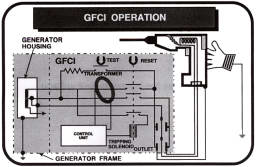
| | GFCI Operation | |  | Detects ground faults in tools or appliances. |  | GFCI opens the power circuit. |  | TEST button creates ground fault situation for testing GFCI receptacle. |
|
|
GFCI TESTING Under normal operations, the GFCI should be tested monthly. There is a test card located on the control panel to record the date of each test. If the generator is stored outdoors, unprotected from the weather, test the GFCI receptacle before each use. Testing - You must test it to make sure it works!  Press the TEST button. The RESET button should extend with a click. Press the TEST button. The RESET button should extend with a click.
 Press the RESET button. The RESET button should be flush with the TEST button. Press the RESET button. The RESET button should be flush with the TEST button.
If either of these tests fail on a Honda generator, contact an authorized Honda generator servicing dealer.
. |
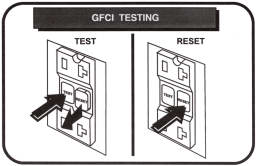
| | GFCI Testing | |  | Test monthly normally. |  | Test before each use if stored outdoors. |
|
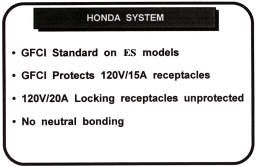
| | Honda and Other High Quality Makes | |  | GFCI is standard on some models. |  | GFCI will protect 120V duplex receptacles. |  | 20, 30 and 50 Amp 120V receptacle |  | Isolated ground system – no neutral bond with the frame. |
|
|
NEUTRAL BONDING REQUIREMENTS Bonding the neutral wire to ground is required on some construction sites. Industrial Generators provide neutral bonding. Some models are neutral bonded which allows the industrial generator to pass OSHA job site inspections.
|
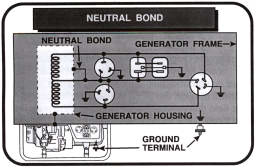
| | Neutral Bond | |  | Required on certain job sites. |  | Neutral conductors bonded to ground. |  | Standard on some Honda & Pramac ES models. |
|
|
SYSTEM GROUND The power tool has a ground wire that connects the tool body to the generator receptacle. The generator ground terminal is connected to: the frame of the generator, the metal non-current carrying parts of the generator, and the ground terminals of each receptacle. Before using the ground terminal, consult a qualified electrician, electrical inspector or local agency having jurisdiction for local codes or ordinances that apply.
|
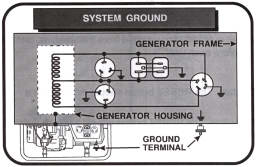
| | System Ground | |  | Generator frame acts as system ground. |  | Local codes or agencies may require further generator grounding. |
|
|
TURN THE CIRCUIT BREAKER OFF SAFETY PRECAUTION! Turn the circuit breaker OFF when starting the generator. The generator starts producing power immediately after the engine starts. Start the generator and wait 15 seconds to let it come up to speed and generate the proper voltage, then turn the loads on. If there is a heavy load connected to the generator, it may be strong enough to make the engine hard to start. If the engine does not start, a heavy load may not allow the engine to reach operating speed. Continuous operation of the generator below normal operating speed may damage the load or the generator. The circuit breaker should be switched OFF before stopping the engine. The generator will produce power until the engine comes to a complete stop. AVR generators will try to produce steady output as the generator winds down. This may overload the AVR circuits, which could damage the AVR.
|

| | STOPPING THE GENERATOR | | |  | Turn OFF the circuit breaker before starting the engine. |  | Turn OFF the circuit breaker before stopping the engine. |
|
|
TURN OFF THE FUEL VALVE (if equipped) Turn the fuel valve OFF when transporting or storing the generator. When the generator is being transported, the carburetor inlet needle may unseat allowing fuel to enter the engine crankcase. Gasoline will dilute the engine oil reducing the lubrication properties and cause severe engine damage.
|
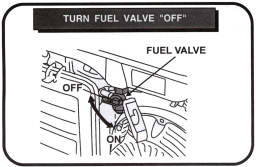
| | Turn The Fuel Valve OFF | |  | Turn OFF the fuel valve when transporting the generator. |  | Turn OFF the fuel valve when the generator is not in use. |
|
|
![]() Do not smoke or allow sparks in the area when refueling.
Do not smoke or allow sparks in the area when refueling.![]() Never refuel while the engine/generator is running. Refuel the generator with the engine stopped and the engine cool.
Never refuel while the engine/generator is running. Refuel the generator with the engine stopped and the engine cool.![]() Wipe up spilled fuel before starting the generator. The engine produces enough heat at the exhaust system, and the generator produces sufficient static electricity, to ignite the fuel vapors.
Wipe up spilled fuel before starting the generator. The engine produces enough heat at the exhaust system, and the generator produces sufficient static electricity, to ignite the fuel vapors.










